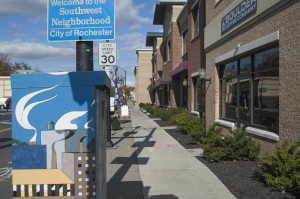In 2010, Campus Times ran an article about the early stages of the Brooks Landing land development process. The slow economy was making it difficult for Minneapolis-based Christensen Development Corporation to attract retailers to fill the empty storefronts. It was both the developer’s and the University’s hope, along with the Sector 4 Community Development Corporation, that this project would increase economic activity in a location that both students and Rochester natives reside in. In August 2005, UR President Joel Seligman told the Democat & Chronicle that he saw Brooks Landing as “possibly the first steps in the development” of a college town.
Three years have passed since the 2010 CT article, and in that time the College Town project is on Mt. Hope Avenue. Nevertheless, Brooks Landing development has progressed. To date, the project has had $38 million invested into various businesses, parks, and road improvements, according to Joan Roby-Davison, executive director of Sector 4 Community Development, a community organization that advocates for development and community outreach in the Southwest Quadrant of Rochester.
In the beginning of the semester, the side parking lot of Staybridge Suites on Genesee St. was reduced to rubble. Since, the skeleton of an 11-story apartment has been constructed. Approximately 75 percent of Staybridge employees are local residents, a move “that is not just good business; it’s the right thing to do,” Roby-Davison said.
“The 11-story building will be primarily student housing, so the University is the main tenant for that building,” UR Senior Vice President and Chief Financial Officer Ronald Paprocki said.
Approximately 170 students are estimated to move into the building. The ground floor has been reserved for a restaurant, although the developer has yet to find a tenant. Construction is expected to be completed by fall 2014.
The Brooks Landing project has been a joint public and private venture between the University, Christensen Development Corporation, the City of Rochester, and various community groups and business associations, including The Sector 4 Community Development Corp.
“The University has been working closely with the developer of the project on the next phase of the development,” Paprocki said, adding that the new apartment building was designed specifically to undergraduate housing specifications.
John DeMott of Sector 4 Community Development Corporation, and Dave Etzel, owner of Jim Dalberth Sporting Goods on 925 Genesee Street, were able to shed some light on the economic history, progress, and the changing relationship of collaboration of the Brooks Landing “Urban Village” District.
“You’ve got to take yourself back to 10 or 15 years ago, back when most of the buildings on Genesee Street were derelict,” DeMott said.
Through community collaboration, between both Sector 4, UR, and Christensen Development, new buildings and businesses have sprung up.
According to Etzel, during the initial stages of the Brooks Landing development, it was the belief that the businesses of Genesee St. would be brought up as well to give the perception of unified development. During this time, a number of façade grants were awarded to upgrade the fronts of stores up and down the street.
One common misconception is that Brooks Landing is limited to the business center that houses California Rollin, Subway, and Boulder and the Staybridge Suites. In reality, the entirety of the Brooks Landing District touches from one end of Genesee St. by the United League’s office space heading towards downtown Rochester all the way to the new Woodstone Custom Houses in the direction of Scottsville Road.
“The business plan around here is to find a business that can appeal to both local residents and UR students because either one by themselves wouldn’t work,” Etzel said, whose sporting goods store has been serving Rochester and its surrounding communities for over 50 years.
“We’re a neighborhood that’s been here a long, long time. We’ve tried to attract businesses that would bring people together,” DeMott said. Both Boulder Coffee and Brooks Landing Diner are two businesses that reflect this.
Some assert, however, that the slow economy has been a major contributor to Brooks Landing’s economic growth. Etzel believes that the “big chain theory,” the belief that the large chain retailers will trump small businesses, has dictated some of the success in areas like Henrietta and Pittsford.
Both Etzel and DeMott agree, though, that despite the small presence of RIT and MCC students in the 19th Ward, many business owners in the Brooks Landing District look to UR students as a significant market.
Some perceive the 19th Ward as a dangerous area to visit, but DeMott urges students to be realistic.
“Students must remember they are in an urban area. Just be aware of your surroundings and take your headphones out of your ears,” DeMott said.
DeMott and Etzel assure students and other visitors of the Brooks Landing District that they will be greeted with a small town feeling and friendly faces. DeMott, in response to the recent College Town groundbreaking, maintains, “Businesses in this neighborhood will remember you and they will know your name. We’re never going be as big as College Town, but we’re gonna give you the friendly alternative.”
Gilboard is a member of the class of 2015.
